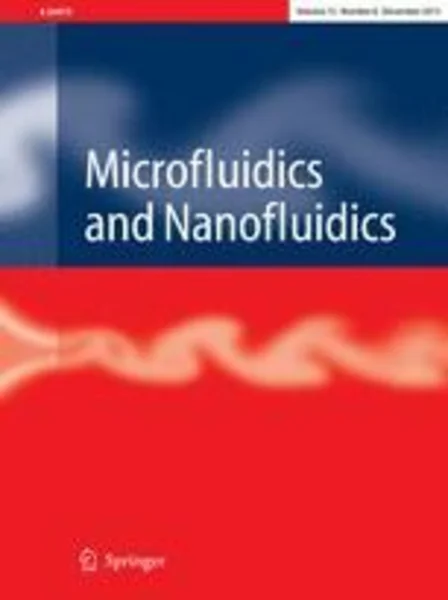-
chemotherapy efficiency increase via shock wave interaction with biological membranes: a molecular dynamics study
جزئیات بیشتر مقاله- تاریخ ارائه: 1392/07/24
- تاریخ انتشار در تی پی بین: 1392/07/24
- تعداد بازدید: 1213
- تعداد پرسش و پاسخ ها: 0
- شماره تماس دبیرخانه رویداد: -
application of ultrasound to biological tissues has been identified as a promising cancer treatment technique relying on temporal enhancement of biological membrane permeability via shock wave impact. in the present study, the effects of ultrasonic waves on a 1,2-dipalmitoyl-sn-phosphatidylcholine biological membrane are examined through molecular dynamics simulations. molecular dynamics methods traditionally employ periodic boundary conditions which, however, restrict the total simulation time to the time required for the shock wave crossing the domain, thus limiting the evaluation of the effects of shock waves on the diffusion properties of the membrane. a novel method that allows capturing both the initial shock wave transit as well as the subsequent longer-timescale diffusion phenomena has been successfully developed, validated and verified via convergence studies. numerical simulations have been carried out with ultrasonic impulses varying from 0.0 to 0.6 mpa s leading to the conclusion that for impulses ≥0.45 mpa s, no self-recovery of the bilayer is observed and, hence, ultrasound could be applied to the destruction of localized tumor cells. however, for impulses ≤0.3 mpa s, an increase in the transversal diffusivity of the lipids, indicating a consequent enhancement of drug absorption across the membrane, is initially observed followed by a progressive recovery of the initial values, thereby suggesting the advantageous effects of ultrasound on enhancing the chemotherapy efficiency.
مقالات جدیدترین رویدادها
-
استفاده از تحلیل اهمیت-عملکرد در ارائه الگوی مدیریت خلاقیت سازمانی و ارائه راهکار جهت بهبود
-
بررسی تاثیر ارزش وجوه نقد مازاد بر ساختار سرمایه شرکت های پذیرفته شده در بورس اوراق بهادار تهران
-
بررسی تأثیر سطح افشای ریسک بر قرارداد بدهی شرکت های پذیرفته شده در بورس اوراق بهادار تهران
-
بررسی تأثیر رتبه بندی اعتباری مبتنی بر مدل امتیاز بازار نوظهور بر نقد شوندگی سهام با تأکید بر خصوصی سازی شرکت ها
-
تأثیر آمیخته بازاریابی پوشاک ایرانی بر تصویر ذهنی مشتری پوشاک ایرانی (هاکوپیان)
-
تاثیر نوع استراتژی و توانمندی های سازمانی بر عملکرد: نقش میانجی تکنیک های حسابداری مدیریت
-
ارزیابی توزیع فضایی بافت فرسوده در شهر آبدانان و ارائه الگوی بهینه مداخله در آن
-
مدل سازی استاتیک مخزن دالان در یکی از میادین جنوب ایران
-
تعیین پارامتر های موثر در حمل و نقل مطلوب شهری با استفاده از روش ahp نمونه موردی شهر شیراز
-
سیرالولیاء؛ مستندترین تذکره در شرح احوال مشایخ سلسله چشتیه
مقالات جدیدترین ژورنال ها
-
مدیریت و بررسی افسردگی دانش آموزان دختر مقطع متوسطه دوم در دروان کرونا در شهرستان دزفول
-
مدیریت و بررسی خرد سیاسی در اندیشه ی فردوسی در ادب ایران
-
واکاوی و مدیریت توصیفی قلمدان(جاکلیدی)ضریح در موزه آستان قدس رضوی
-
بررسی تاثیر خلاقیت، دانش و انگیزه کارکنان بر پیشنهادات نوآورانه کارکنان ( مورد مطالعه: هتل های 3 و 4 ستاره استان کرمان)
-
بررسی تاثیر کیفیت سیستم های اطلاعاتی بر تصمیم گیری موفق در شرکتهای تولیدی استان اصفهان (مورد مطالعه: مدیران شرکتهای تولیدی استان اصفهان)
-
صنعت خودروی تجاری ایران از منظر بازگران: راهکارهایی برای توسعه
-
بررسی تاثیر وابستگی به گروه تجاری بر انتخاب حسابرس
-
واکاوی تهدیدها و فرصت های جذب سرمایه گذاری در صنعت پتروشیمی از دیدگاه کارکنان شپترو
-
the management of capital assets life cycle in petrochemical industry
-
influence of polypropylene length on stability and flow of fiber-reinforced asphalt mixtures




سوال خود را در مورد این مقاله مطرح نمایید :